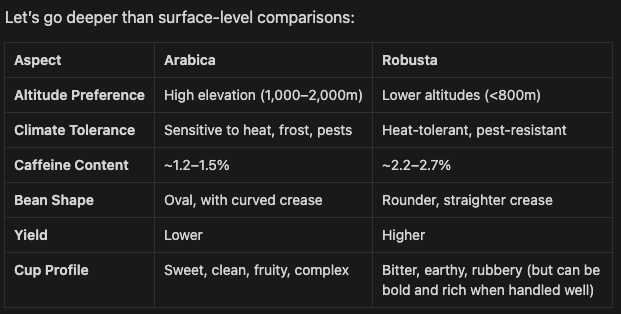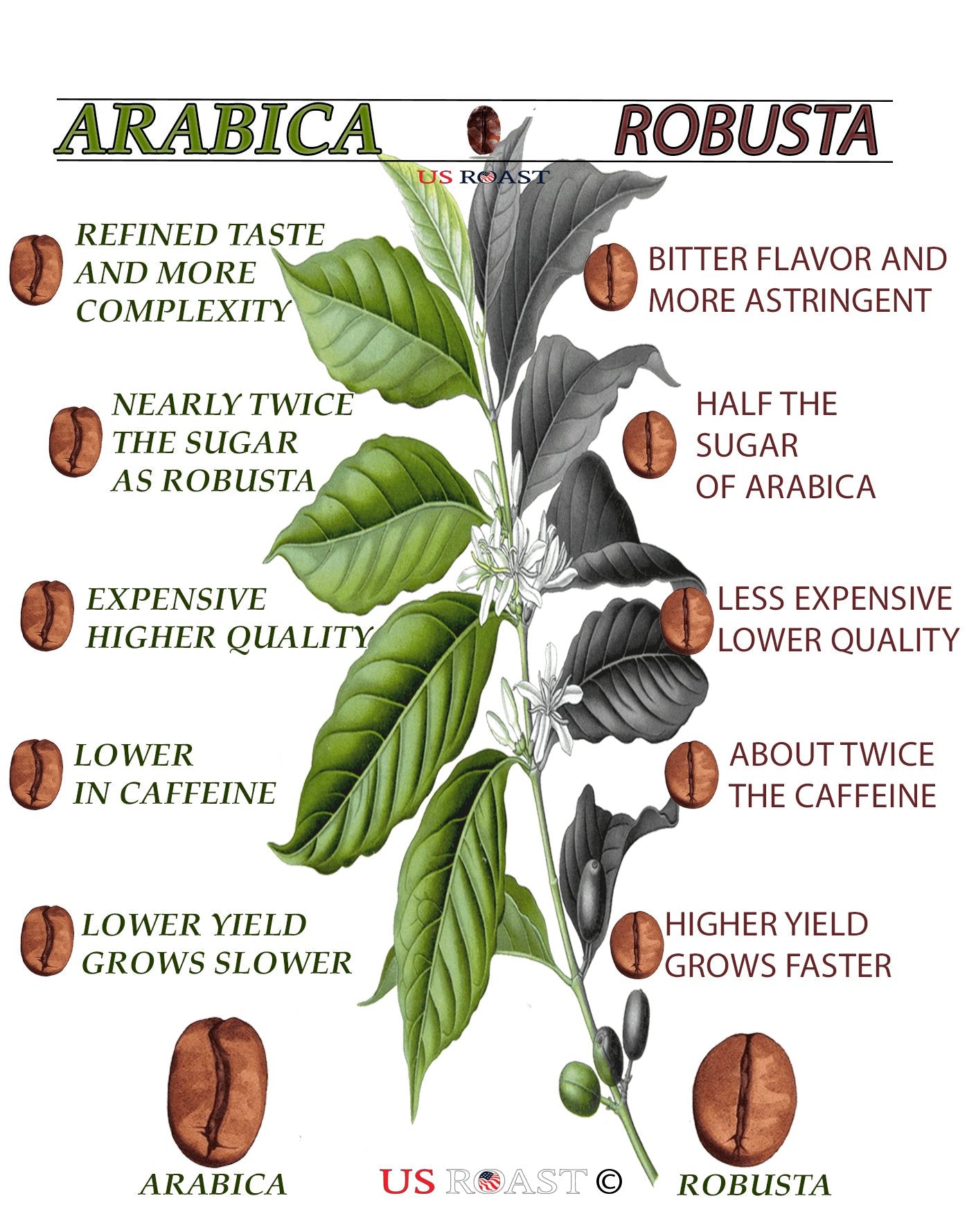What is Arabica Coffee
When I first started drinking coffee, I’d spot labels that proudly said “100% Arabica” and immediately assumed it was a mark of quality. It sounded exclusive — like “100% silk” or “100% natural.” I never questioned it. I didn’t even know what Arabica meant. I just figured it must be good, because hey, no one puts “100%” on a bad thing… right?
Fast forward five years and I’ve somehow spiraled into the deep end of coffee — origin, varietals, processing methods, roast curves, you name it. And here I am, finally writing the post I once needed to read: what actually is Arabica coffee, and why does it matter?
Let’s unpack the hype, the science, and the reality behind this bean.
From this article, you will learn about...
First: Arabica is a species — not a roast, not a flavor
Arabica coffee comes from the plant Coffea arabica, one of over a hundred species in the coffee family — but only two are commercially significant: Arabica and Robusta (a.k.a. Coffea canephora).
Arabica is by far the most commonly consumed globally, making up around 60–70% of the world’s coffee production. It’s generally associated with higher-quality flavors, but that doesn’t mean every Arabica is great, nor every Robusta is bad. Like grapes in wine, the species sets the stage — but how it’s grown, processed, roasted, and brewed defines the final cup.
Arabica has 44 chromosomes (as opposed to Robusta’s 22), which contributes to its more complex flavor compounds — a big reason why specialty coffee often revolves around it. But Arabica also comes with a catch: it’s incredibly high-maintenance.
Arabica is harder (and more expensive) to grow
The plant prefers higher altitudes (ideally above 1,200 meters) with cool, stable temperatures and steady rainfall. It’s sensitive to heat, pests, disease, and even slight fluctuations in the environment. This means:
- Lower yields compared to Robusta
- Higher vulnerability to climate change
- More labour-intensive cultivation and harvesting
- Smaller margin of error from farm to roast
In short: Arabica is delicate. It demands more — and when done right, rewards with better flavor. But that labor and risk? It reflects in the price.
By contrast, Robusta is a tank. It grows at lower altitudes, tolerates harsher conditions, yields more per plant, and contains twice as much caffeine, which acts as a natural insect repellent. This makes Robusta far cheaper to farm and more consistent in large-scale production.

Who's Better?
Arabica VS Robusta

Arabica offers a broader and more refined flavor spectrum. In a single cup, you might find notes of jasmine, citrus, tropical fruit, chocolate, or honey, depending on the varietal, processing, and roast. Robusta leans toward strong, bitter, woody, or smoky notes — which isn’t always bad, especially in darker espresso blends or regional styles like Vietnamese cà phê sữa đá.
But here’s the catch: not all Arabica is high-quality, and not all Robusta is low-quality. It’s just that Robusta is typically farmed and roasted with volume in mind, not complexity.
Arabica coffee grows globally, but thrives only in certain conditions
Arabica originated in Ethiopia, where wild heirloom varieties still grow today. From there, it spread to Yemen, then through colonial trade to the Americas and Asia. Today, some of the most prized Arabica comes from:
- Ethiopia – Bright, floral, tea-like. Home to heirloom varieties like Yirgacheffe and Sidamo.
- Kenya – Complex acidity, berry and citrus flavors, often SL28 or SL34 varietals.
- Colombia – Balanced, sweet, round body; Castillo and Caturra are common.
- Brazil – Chocolatey, nutty, low acidity; lots of Bourbon and Mundo Novo.
- Panama – Home of the highly aromatic and expensive Geisha varietal.
- Indonesia – Earthy and spicy; includes Java, Sumatra, and Bali regions.
Each growing region adds its own terroir — a term borrowed from wine — referring to how soil, climate, and altitude influence flavor. And that’s not even getting into processing methods (washed, natural, honey), which further shape how Arabica tastes in your cup.
Arabica is chemically complex
Arabica beans contain more sucrose (sugar) and lipids (fats) than Robusta, contributing to a smoother, sweeter flavor profile and better mouthfeel when roasted well. They also have a broader range of volatile aromatic compounds, which means greater potential for tasting notes like fruit, florals, herbs, or nuts.
This is why Arabica is the star of the specialty coffee movement. It has the capacity for nuance — and nuance is what coffee lovers chase.
Varietals of Arabica: Not all Arabica is the same
The term “Arabica” is a species, but within it are hundreds of varietals and cultivars — each with their own growing needs, disease resistance, and flavor potential. Think of it like dog breeds: a chihuahua and a husky are both dogs, but very different.
Some key Arabica types:
- Typica – The original varietal. Balanced, clean cup.
- Bourbon – Sweeter, fuller body.
- SL28 / SL34 – Developed in Kenya; juicy, acidic, complex.
- Caturra / Catuai – Compact hybrids for higher yield; common in Latin America.
- Geisha (Gesha) – Floral, tea-like, exotic, delicate — and very expensive.
- Pacamara – Large bean, bold flavors, citrusy.
- Castillo – Rust-resistant varietal developed in Colombia; balanced, clean.
Farmers often choose varietals based on their growing conditions, flavor goals, and disease pressures — which is why knowing the varietal can tell you a lot more about your coffee than just “100% Arabica.”
So… should “100% Arabica” mean anything to you?
Yes and no.
✅ It tells you the coffee probably won’t be as bitter or rubbery as low-end Robusta blends.
✅ It likely has more flavor complexity and sweetness potential.
❌ It doesn’t tell you where it’s from, how fresh it is, or if it was roasted well.
❌ It doesn’t mean the beans are high grade or traceable.
To really choose better coffee, go beyond the Arabica stamp. Ask about:
- The origin country and farm
- Processing method
- Roast date
- Flavour notes and roast level
- Varietal, if listed
Final Thoughts
Arabica isn’t just a label — it’s a massive category filled with history, biology, and diversity. While it’s generally the more refined and desirable of the two main species, Arabica alone doesn’t make a coffee great. Great coffee is grown with intention, processed with care, roasted with understanding, and brewed with respect.
If you’re just beginning your journey — start with Arabica, but stay curious.
If you’ve been in the game a while — start exploring the layers within Arabica.
And if you’re ready for wild cards — try Robusta with an open mind. The future of coffee might be more complex than the Arabica vs Robusta divide.

